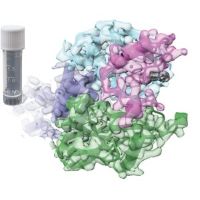Specification
| Organism | Homo sapiens (Human) |
| Expression Host | Mammalian cell |
| Tag Info | N-terminal hFc-Myc-tagged |
| Purity | Greater than 90% as determined by SDS-PAGE. |
| Uniprot ID | P41273 |
| Uniprot Entry Name | |
| Gene Names | TNFSF9 |
| Alternative Names | (4-1BB ligand) (4-1BBL) |
| Expression Region | Partial (71-254aa) |
| Molecular Weight | 48.0 kDa |
| Endotoxin | Less than 1.0 EU/ug as determined by LAL method. |
| Sequence | REGPELSPDDPAGLLDLRQGMFAQLVAQNVLLIDGPLSWYSDPGLAGVSLTGGLSYKEDTKELVVAKAGVYYVFFQLELRRVVAGEGSGSVSLALHLQPLRSAAGAAALALTVDLPPASSEARNSAFGFQGRLLHLSAGQRLGVHLHTEARARHAWQLTQGATVLGLFRVTPEIPAGLPSPRSE |
| Product Form | Lyophilized powder (Lyophilized from a 0.2 μm filtered PBS, 6% Trehalose, pH 7.4) |
| Reconstitution | We recommend that this vial be briefly centrifuged prior to opening to bring the contents to the bottom. Please reconstitute protein in deionized sterile water.We recommend to add 5-50% of glycerol (final concentration) and aliquot for long-term storage at -20℃/-80℃. Our default final concentration of glycerol is 50%. Customers could use it as reference. |
Background
| Relevance | Cytokine that binds to TNFRSF9. Induces the proliferation of activated peripheral blood T-cells. May have a role in activation-induced cell death (AICD). May play a role in cognate interactions between T-cells and B-cells/macrophages. |
| Function | |
| Involvement in disease | |
| Subcellular Location | |
| Protein Families | |
| Tissue Specificity | |
| Pathway |
QC Data
| Note | Please contact us for QC Data |
| Product Image (Reference Only) |  |

